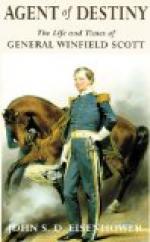Lane a larger force than he had fought at Chippewa;
but he determined to give battle and rely upon re-enforcements
being rapidly sent to him. Lieutenant Richard
Douglass was now dispatched to inform General Brown
of the situation. On the night of the 23d Lieutenant-General
Sir Gordon Drummond had arrived at the mouth of the
river with re-enforcements. This was not known
to General Brown. Riall had marched down the road
which Scott was to have taken on the 26th, coming by
Queenstown, and had not sent any troops across the
Niagara. His re-enforcements were coming up rapidly.
The battle opened late in the afternoon. The
British line, eighteen hundred strong, posted on a
ridge in Lundy’s Lane running at right angles
with the river, was in front of Scott. The left
of this line was on a road parallel to the river, with
a space grown up with small timber, extending some
two hundred yards. He ordered Major Jesup and
Colonel Brady to take advantage of this and turn the
enemy’s left from the concealed position which
the brushwood afforded. The other infantry forces
had been placed in line with detachments of cavalry
on both sides and held as reserves. The British,
outflanking Scott on the left, made a movement to attack
in flank and fear. This was repelled by Major
McNeil with heavy loss. Jesup had succeeded in
his movement, while Brady, Leavenworth, and Towson
were engaged in the front. Jesup had captured
General Riall and a number of other officers far in
his front, and then resumed his line. At nine
o’clock the British right was driven back from
its assault on Scott’s flank, and his left was
turned and cut off. The center posted on the
ridge held its place, supported by nine pieces of
artillery. Another battalion of British troops
was on its way as a re-enforcement, and but a short
distance away, when General Brown arrived on the field,
in advance of the reserve. He thus describes in
his report what occurred from the time of his arrival:
“Apprehending that these corps were much exhausted,
and knowing that they had suffered severely, I determined
to interpose a new line with the advancing troops,
and thus disengage General Scott and hold his brigade
in reserve. Orders were accordingly given to General
Ripley. The enemy’s artillery at this moment
occupied a hill which gave him great advantage and
was the key to the whole position. It was supported
by a line of infantry. To secure the victory it
was necessary to carry this with artillery and seize
the height.
“The duty was assigned to Colonel Miller.
He advanced steadily and gallantly to his object,
and carried the height and the cannon. General
Ripley brought up the Twenty-third (which had faltered)
to his support, and the enemy disappeared from before
them. The enemy, rallying his forces, and, as
is believed, having received re-enforcements, now
attempted to drive us from our position and regain
his artillery. Our line was unshaken and the enemy
repulsed. Two other attempts having the same




